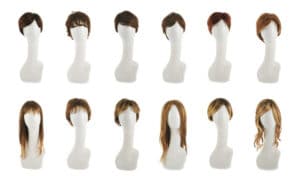Our website is supported by our users. This site contains affiliate links. If you click such a link and make a purchase, we may earn a commission for our endorsement, recommendation, testimonial, and/or link to any products or services from this website. Contact us for Questions

Choosing Wigs For Hair Loss
Choosing Wigs For Hair Loss
Women feel a personal connection with their hair and over the years will invest countless amounts time and money into maintaining or refreshing their look. When a woman endures hair loss, it is a difficult experience wherein she may feel vulnerable and struggle with her identity. Clinical side effects include anxiety, fear and depression. No matter why a woman loses her hair, a little preparation and positive thinking can really help her through the transition.
If you are suffering from hair loss, it’s important for you to know that you aren’t alone. Hair loss is not simply a male affliction. Today, the American Hair Loss Association reports that women account for 40% of hair loss cases, which includes 90 million women. In over 50% of these instances, the hair loss is genetic, but illness and age also commonly affect many other women.
Although admitting hair loss is affecting you can be difficult, when you are ready to consider your options, Wigsuperstore.com is your ultimate resource for information about hair replacement.
Preparing To Wear A Wig
Once you decide that you are ready to wear a wig, there are some steps you can take to prepare. If you are suffering from hair loss associated with cancer treatment, the American Cancer Society says you will begin to see effects within two weeks and can expect the loss to get progressively worse over time. However, many insurance companies will cover the costs associated with purchasing a wig to handle cancer-related hair loss, so ask your doctor for a prescription. We recommend you purchase your wig before you begin treatment or soon after in order to get acquainted with your new hairstyle and feel comfortable.
Before hair loss occurs entirely, you should consider cutting your hair short to reduce shedding. The hair should not be shaved or less than 1.5 inches long to reduce irritation when wearing the wig. You should continue to care for your scalp as normal with shampoo and conditioner to help circulation and prevent drying the skin as body washes and soaps would. If your scalp is sensitive, you can apply a facial moisturizer to ease the irritation, however, regular body lotion is too oily for use on the scalp.
Choosing A Wig
Wearing a wig for the first time can be confusing and intimidating. Not only are you managing illness, hereditary, or age-related symptoms, you now have to incorporate a new step in your daily routine. Local wig store experts can help you prepare and learn how to handle your hair loss and choose your new wig with ease.
Generally, consideration should be given to monotop or monofilament wigs for their lightweight comfort and ventilation attributes. Medical patients with extremely sensitive scalps may want to try the more expensive hand-tied tops because they are seamless and cause the least amount of irritation possible.
Choosing a style and color for your wig should be a fun process. Often, this gives a woman an opportunity to try new looks she has always wanted and reinvent her attitude about hair loss. No matter what color and style of wig you choose, it is important that you maintain positive outlook during this transition. A negative attitude can affect your physical and mental health during a time when you need your strength. Simply ask questions and seek advice before purchasing your wig, and you will be sure to enjoy your new investment.







